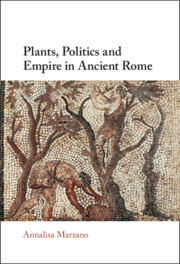Book contents
- Plants, Politics and Empire in Ancient Rome
- Plants, Politics and Empire in Ancient Rome
- Copyright page
- Dedication
- Contents
- Figures
- Tables
- Acknowledgments
- Abbreviations
- Introduction
- Chapter 1 Roman Gardens, Representation, and Politics
- Chapter 2 Arboriculture, ‘Botanical Imperialism’, and Plants on the Move
- Chapter 3 The Augustan ‘Horticultural Revolution’
- Chapter 4 Grafting Glory
- Chapter 5 Of Peaches and Peach Trees
- Chapter 6 Campania and Cisalpine Gaul:
- Chapter 7 Plant Dispersal and Provincial Agriculture
- Chapter 8 Viticulture versus Arboriculture
- Conclusions
- Bibliography
- Index
Chapter 7 - Plant Dispersal and Provincial Agriculture
The Iberian Peninsula and Gaul
Published online by Cambridge University Press: 06 October 2022
- Plants, Politics and Empire in Ancient Rome
- Plants, Politics and Empire in Ancient Rome
- Copyright page
- Dedication
- Contents
- Figures
- Tables
- Acknowledgments
- Abbreviations
- Introduction
- Chapter 1 Roman Gardens, Representation, and Politics
- Chapter 2 Arboriculture, ‘Botanical Imperialism’, and Plants on the Move
- Chapter 3 The Augustan ‘Horticultural Revolution’
- Chapter 4 Grafting Glory
- Chapter 5 Of Peaches and Peach Trees
- Chapter 6 Campania and Cisalpine Gaul:
- Chapter 7 Plant Dispersal and Provincial Agriculture
- Chapter 8 Viticulture versus Arboriculture
- Conclusions
- Bibliography
- Index
Summary
This chapter examines the changes in agricultural practices and the dispersal of new plants in the Iberian Peninsula and in the Gallic provinces after their incorporation into the Roman empire. It investigates the effects colonization may have had on agricultural practices. The provinces chosen as case studies were the object of large colonization programmes organized by Caesar and Augustus.Although the available archaeobotanical data for these regions is uneven, it is possible to detect in these provincial territories similar trends to those observed for Roman Italy: an increase, in the late first century BC, with notable peaks in the early first century AD, in the number and variety of horticultural produce available. The evidence from northern and northeastern France and the western Netherlands suggests a connection between the presence of the army and the import of new plant foods first, and the local cultivation of some of these new plants later. Such evidence offers a compelling picture for the diffusion of cultivation techniques and dietary changes that took place in the early empire.
Keywords
- Type
- Chapter
- Information
- Plants, Politics and Empire in Ancient Rome , pp. 233 - 275Publisher: Cambridge University PressPrint publication year: 2022

